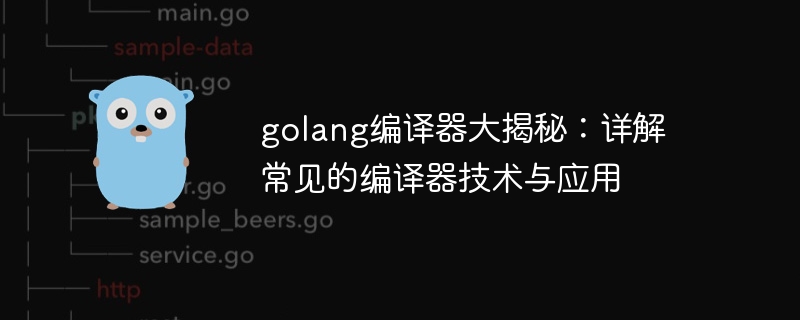
Golang Compiler Revealed: Detailed explanation of common compiler technologies and applications
Introduction:
With the continuous development of computer technology, compilers are playing an important role in software development is becoming increasingly important. As a high-level programming language, Golang's compiler has many excellent performances in improving development efficiency while ensuring code execution efficiency. This article will delve into the various technologies and applications of the Golang compiler, revealing the secrets and working principles behind it.
1. Front-end technology
- Lexical Analysis
Lexical analysis is the first step of the compiler, which divides the source code into lexical units ( Tokens). The Golang compiler uses the Lexer tool to implement the lexical analysis process and convert the source code into an abstract syntax tree by identifying keywords, identifiers, constants, etc.
- Syntax Analysis
Syntax analysis is the second step of the compiler, which converts lexical units into a syntax tree. The Golang compiler uses the Parser tool to implement the syntax analysis process, organizing lexical units into a tree structure through rules and productions. At the same time, the syntax analyzer will also check for syntax errors and generate corresponding error messages.
- Semantic Analysis
Semantic analysis is the third step of the compiler. It mainly verifies and corrects the syntax tree to ensure the logical correctness of the program. The Golang compiler will check the declaration and use of variables, type matching and other issues, and provide error prompts. In addition, semantic analysis also performs operations such as type inference and type conversion to generate correct intermediate code.
2. Intermediate code generation
- Intermediate code
Intermediate code is an abstract representation of the compiler before it generates the target code. The Golang compiler uses an intermediate code representation called SSA (Static Single Assignment). The SSA intermediate code has controllable data flow and control flow to facilitate various optimization operations.
- Control Flow Graph
The control flow graph is a data structure used to describe the control flow of a program. It consists of a set of basic blocks (Basic Block) and a special entrance and exit. Composed of blocks. The Golang compiler analyzes the control flow of the program by building a control flow graph for subsequent data flow analysis and optimization.
3. Back-end technology
- Data Flow Analysis
Data flow analysis is a key technology of the compiler, which can analyze the program Variables and operations are tracked and analyzed for various optimization operations. The Golang compiler will apply data flow analysis algorithms such as active variable analysis, reachability analysis, and copy propagation to improve program execution efficiency.
- Optimization technology
Optimization is one of the important tasks of the compiler. It can improve the execution efficiency of the program as much as possible while ensuring that the program functions are correct. The Golang compiler uses various optimization techniques, such as constant folding, loop expansion, function inlining, etc., to improve the quality of the generated target code.
- Target code generation
Target code generation is the last step of the compiler, which converts the intermediate code into machine code for the target machine. The Golang compiler uses a data structure called a Code Generation Graph to gradually generate target code by continuously adding nodes and edges to the graph.
4. Practical Application
- Cross-compilation
The Golang compiler has cross-compilation capabilities and can compile program source code into executable files on other target platforms . This feature allows developers to use only one host to complete software development and testing for different platforms, greatly improving development efficiency and flexibility.
- JIT compilation
Just-In-Time Compilation (Just-In-Time Compilation) is a technology that converts bytecode (or intermediate code) into machine code when the program is running. The Golang compiler can compile the program on-the-fly during runtime by implementing a JIT compiler to improve the execution speed of the program. This is especially effective for code segments that need to be executed frequently.
- Dynamic code generation
Dynamic code generation is a technology that dynamically generates specific functions of a program into machine code and executes it. The Golang compiler can generate dynamic code through specific APIs at runtime, thereby improving program flexibility and performance. This has important applications in certain scenarios, such as database systems, network communications and other high-performance computing fields.
Conclusion:
Through the big reveal of this article, we have an in-depth understanding of the various technologies and applications of the Golang compiler. As a powerful high-level programming language, Golang has put a lot of effort into the design and implementation of the compiler. I believe that in the future development, the Golang compiler will have more innovations and breakthroughs, provide developers with better tools and environments, and help them develop more efficient and reliable software products.
The above is the detailed content of Revealing the secrets of the golang compiler: in-depth analysis of common compiler technologies and applications. For more information, please follow other related articles on the PHP Chinese website!


 what is dandelion
what is dandelion
 How to write batch script bat
How to write batch script bat
 What are the asp development tools?
What are the asp development tools?
 After the computer is turned on, the monitor shows no signal
After the computer is turned on, the monitor shows no signal
 What does xml format mean
What does xml format mean
 What to do if the blue screen code 0x0000007e occurs
What to do if the blue screen code 0x0000007e occurs
 How to solve the problem of garbled characters when opening a web page
How to solve the problem of garbled characters when opening a web page
 The difference between front-end and back-end
The difference between front-end and back-end




